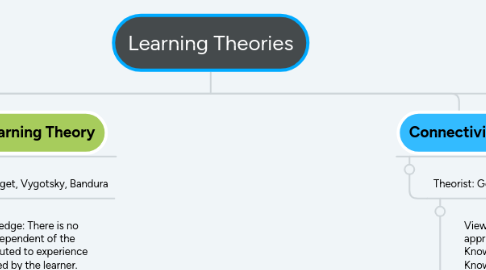
1. Cognitive Learning Theory
1.1. Theorist: Jean Piaget
1.1.1. View of Knowledge: Sensory input is arranged and encoded for storage based on interests, motivations, and perceptions. The individual is constantly involved in organizing vast amounts of knowledge in the form of stimuli.
1.1.1.1. View of Learning: Learning involves the integration of events into active storage systems comprised of organizational structures termed schemata. Schema formulate frameworks into which new information must fit in order to be understood, regulate attention, organize searches of environment, "fill gaps" in information processing, and add to long-term memory.
1.1.1.1.1. Impact on Instruction: One's ability to learn stems from the way one perceives, organizes, stores, and retrieves information. Cognitive approaches include problem-solving and the facilitation of storage and retrieval of information for application.
2. Constructivist Learning Theory
2.1. Theorists: Dewey, Piaget, Vygotsky, Bandura
2.1.1. View of Knowledge: There is no knowledge independent of the meaning attributed to experience and constructed by the learner. Constructing meaning and constructing systems of meaning help gaining knowledge possible. Language influences learning, and learning is a social activity that is intimately associated with our connection with other human beings.
2.1.1.1. View of Learning: The learner thinks about learning. The learner focuses in thinking about learning and its processes, not on the subject or lesson to be taught. Learning is not understanding the nature of things, but rather a personal and social construction of meaning. Learning is also a social activity in that it occurs through through and with interaction with other people.
2.1.1.1.1. Impact on Instruction: These principles appeal to learning that utilizes sensory modes, variety of stimuli, and that attracts a wide range of learners. Connections and context are vital to instruction utilizing this theory.
3. Connectivism
3.1. Theorist: George Siemens
3.1.1. View of Knowledge: Technology-focused approach to knowledge and learning. Knowledge rests in diversity of opinions. Knowledge that resides in a database needs to be connected to people in the right context. In a knowledge economy, the flow of information requires creation, preservation, and utilization to organize activity.
3.1.1.1. View of Learning: Learning is a process of connecting specialized nodes or information sources, either through human or non-human means. In this theory, capacity to know is more critical than what is currently known, and nurturing and maintaining connections is needed to facilitate continual learning. Accurate, up-to-date knowledge (currency) is the intent of all connectivist learning activities.
3.1.1.1.1. Impact on Instruction: Decision-making is a learning process. Therefore, choosing what to learn and the meaning of incoming information is seen through the lens of a shifting reality. There may be a right answer "now" that becomes a wrong answer tomorrow due to alterations in the information climate affecting the decision. Therefore, "currency" of knowledge is key in this approach.
4. Behaviorism
4.1. Theorist: B.F. Skinner
4.1.1. View of Knowledge: Human behavior is the basis of this theory. Scientific and objective pursuits lead to knowledge. Behaviorism emphasizes the role of environmental factors in influencing behavior as opposed to innate or inherited factors.
4.1.1.1. View of Learning: Techniques such as classical and operant conditioning view learning through repeated actions that shape behaviors. For example, there are both negative and positive reinforcements that help shape how individuals learn; if a student practices good study habits, they may be rewarded with additional freedoms or receive positive feedback, while those who demonstrate poor habits may lose recess time or have their parents contacted for a meeting. In education, research suggests positive reinforcement influences behavior far more than negative reinforcement.
4.1.1.1.1. Impact on Instruction: Utilizing behaviorist principles in classroom management and instruction helps teacher see how behaviors are shaped and influenced by external factors. Teacher responses can help reinforce desired behaviors and traits within the classroom.

